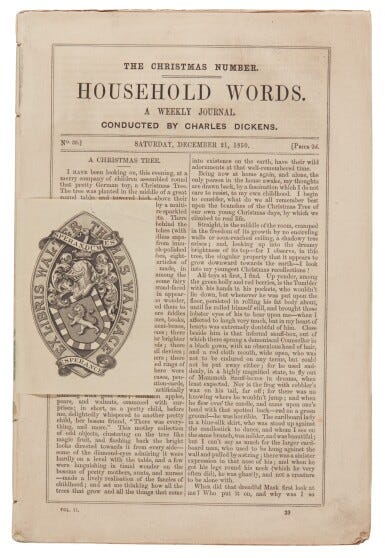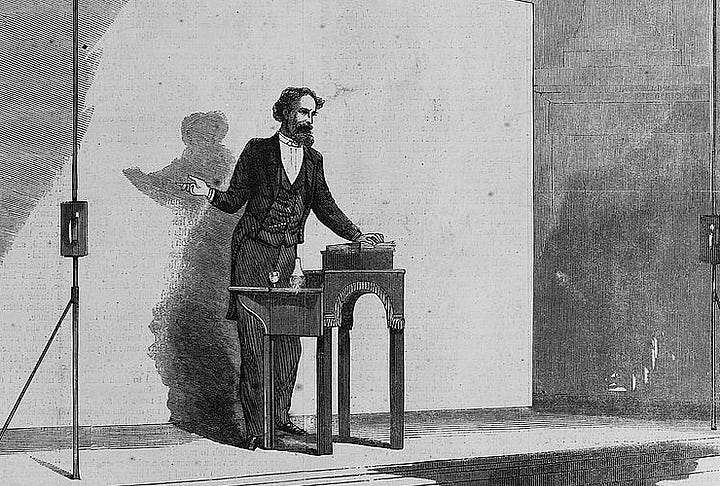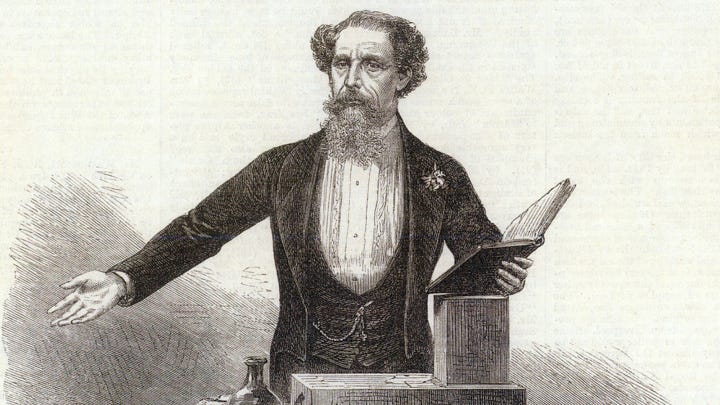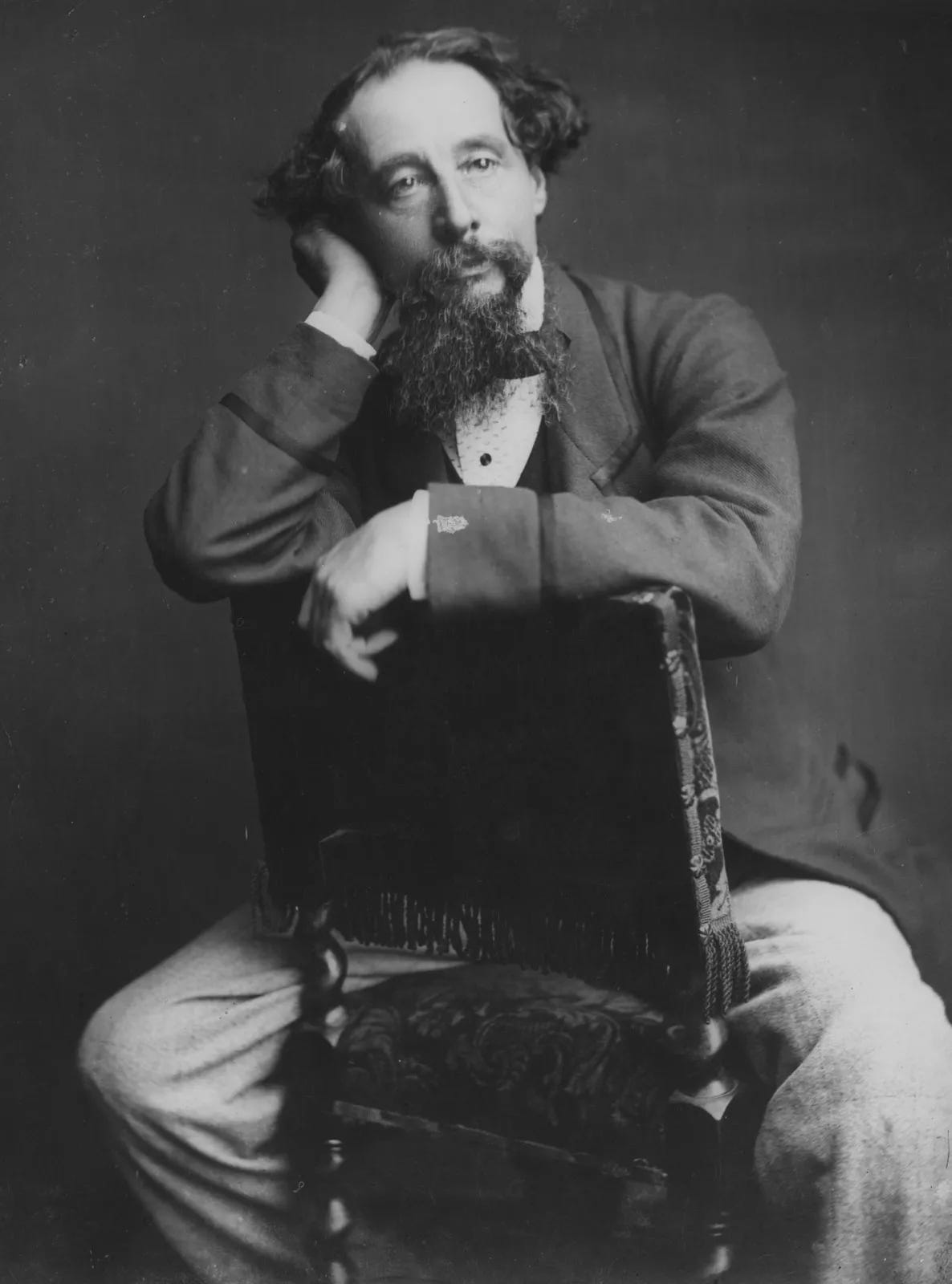Many people know that Charles Dickens serialized his novels (even Lena Dunham mentions this fact). But what most people don’t understand is that Dickens was a journalist before he went into fiction. He understood the serial form and how to hook readers and keep them reading.
His early career was spent doing parliamentary reporting for the Morning Chronicle. He published super popular sketches, i.e., feature articles (that’s right) for no pay. Dickens, the man, became “Boz,” the author. (Boz was his pen name.) His sketches were so popular, they were eventually published in a volume, Sketches by Boz.
He went on to create his own weekly magazine: Master Humphrey’s Clock, where he published stories and eventually a novel. He edited two other magazines—Household Words and All the Year Round—that featured journalism, essays, short stories, and poetry mostly by others.


He also entertained and created relationships with his readers on every level; he invented author readings and the book tour. Dickens gave seventy-six readings, earning over 19,000 pounds (roughly $250,000 by today’s standards) during his second North American tour in 1867. Tickets to his readings were sought-after. In Philadelphia, people lined up in eighteen-degree weather to see him perform at the concert hall. All six readings sold out in just four hours.


(That’s the kind of serialization I want you to write and the career I’d love to see you have.)
Dickens’s skilled performances served as a way for him to connect with his American readers. It was as if the author had granted each member of the audience a personal interview with him. As Malcolm Andrews notes, he used public readings “to convert his readership into companionship.” Dickens opened each reading by thanking the audience and telling them that he was pleased to read to them that evening. In 1858, Dickens wrote of “that particular relation (personally affectionate and like no other man’s) which subsists between me and the public.” For those who could not physically attend one of his readings, newspaper accounts provided the public with a sense for what it was like to be in the author’s presence. The North American wrote that Dickens’s readings were “warmed by expression and clothed with the accessories of a direct personal communication.” Dickens’s ability to clothe his readings in “direct personal communication” made his readings both an intimate and a public affair.
Dickens didn’t just write novels that were serialized; he was a master at writing page-turners that made readers wait with bated breath for the next installment. American readers of The Old Curiosity Shop were so enthralled with the novel that when the book’s protagonist, Little Nell, was in danger, they famously stood on the docks in Boston (or peer in Manhattan, depending on which Dickens scholar you read) calling to sailors aboard ships from England—where the publication was serialized in advance—to find out whether or not the angelic Nell was still alive.
He wrote with the sensibility of a journalist who knew how to hook readers one installment after another. He understood the importance of the basic journalistic who, what, where, when, why.
In the opening paragraph or so of The Old Curiosity Shop, he gives us the who, what, where, when, why. Here it is in full:
Although I am an old man, night is generally my time for walking. In the summer I often leave home early in the morning, and roam about fields and lanes all day, or even escape for days or weeks together; but, saving in the country, I seldom go out until after dark, though, Heaven be thanked, I love its light and feel the cheerfulness it sheds upon the earth, as much as any creature living.
I have fallen insensibly into this habit, both because it favours my infirmity and because it affords me greater opportunity of speculating on the characters and occupations of those who fill the streets.
Here’s how it breaks down:
Although I am an old man (WHO), night is generally my time for walking. In the summer (WHEN) I often leave home early in the morning, and roam about fields and lanes all day (WHAT), or even escape for days or weeks together; but, saving in the country, I seldom go out until after dark (HOW), though, Heaven be thanked, I love its light and feel the cheerfulness it sheds upon the earth, as much as any creature living (WHY).
I have fallen insensibly into this habit, both because it favours my infirmity and because it affords me greater opportunity of speculating on the characters and occupations of those who fill the streets (WHY)…
We’ll look more closely at exactly how Dickens did this in our guided readings, but for now…
Your takeaways:
In a serialized work, you can’t “warm up” or “set the scene” or “establish character.” Start in the middle of things.
Think like a journalist. The first paragraph has to hold the who, what, where, when, and (a little of the) how. That’s how you 1) hook readers and 2) brief readers who may just be joining.
Give your chapters worthy titles that 1) draw readers in and 2) propel your story forward. Chapter 6 won’t do it. That may work in a book but not in a serial. Dickens titled his installments concretely—no abstractions, no obscure allusions, no symbolism. The titles of each installment of The Old Curiosity Shop points to a plot development or character change: The pilgrimage begins, Little Nell’s anxiety, The giants meet the dwarfs, Quilp defies the dog.
Serializing a novel or memoir is an art form—and is nothing new. Until about the 1830s, most works of literature were serialized in magazines and newspapers. Others, such as slave narratives, were distributed in (yes!) pamphlet form—kind of like, let’s say, a newsletter.
The most efficient way to succeed on Substack
Book a meeting! Each 30-minute Zoom meeting is the fastest, most efficient way I can help you.

Book a meeting with Writers at Work with Sarah Fay
I can save you spend years flailing around on Substack, trying to figure out the platform, and not getting any traction.
After working with me, writers have seen their Substacks
double or triple in subscribers,
increase in real engagement, and
been chosen as Featured Substacks.
Most importantly, they’ve found purpose in their writing and direction in their careers. That’s what I want for all of us.
You won’t find this level of mentoring or expertise anywhere else.





I wish I would've found this page sooner, but no matter. I've been serializing my book A BEGINNER'S GUIDE TO TIME TRAVEL (https://benwoestenburg.substack.com/p/a-beginners-guide-to-time-travel) You can look at it here if you want. It's almost finished (as is) because it's a 1st draft. But I plan to put another up after this. So I'm glad to be here.
Any book set in Ames, and I'm in. Great opening: Let me just start off by saying that everything I’m about to tell you is true. And you acknowledge that we're never going to believe a narrator who says that. Glad you're writing another one. I hope you've taken the time to celebrate that you're about to FINISH A BOOK! And start another. Incredible. So many people dream of doing that and so few people do it. Congrats!